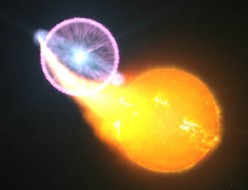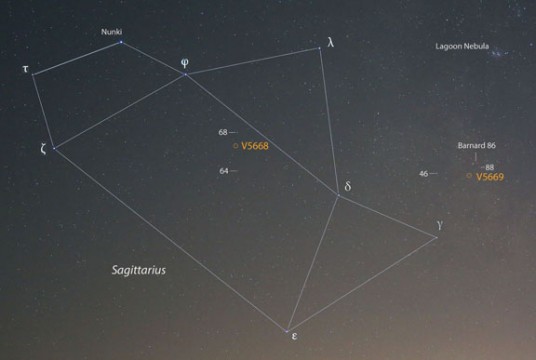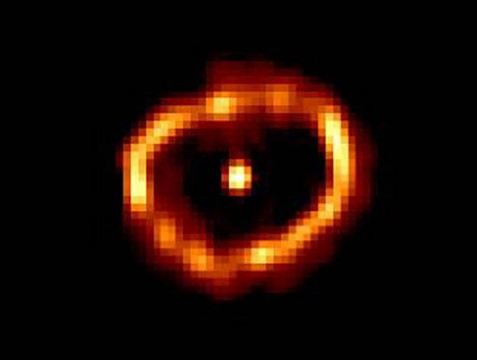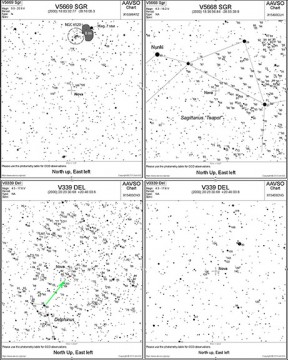Like people doing good imitations, novae often mimic planetary nebulae. Read on to learn how to watch the evolution of these tricksters using a common nebula filter.

NASA Goddard Space Flight Center / S. Wiessinger
Three novae highlight the October sky within reach of small to medium telescopes — V339 Delphini, V5668 Sagittarii, and a brand new discovery, V5669 Sagittarii. Japanese amateur astronomer Koichi Itagaki found the last while patrolling the sky with a 9-inch telescope and CCD camera on September 27, 2015. Itagaki pegged it at magnitude 9.8 at discovery; since then it's risen to about magnitude 9.0 and is easily visible in a small telescope at the end of evening twilight.
Whether it will rocket to new heights or plunge quickly back into the depths of obscurity is anyone's guess, but it's worth keeping an eye on. That's the fun of novae watching — you never know what to expect.
You'll find charts and links for this and the other featured novae in this article below, so you'll have the tools to follow their ups and downs.
Novae occur in close binary star systems where a normal, Sun-like star is paired with a planet-sized, supremely dense white dwarf. Gases captured from the companion by the dwarf accumulate on its surface, where they're compressed and heated through gravity until they reach a flash point. Boom! A powerful thermonuclear explosion lifts the star from obscurity to celebrity.

Bob King
A system that once slumbered away at 15th magnitude or fainter suddenly becomes a "new star" 50,000 to 100,000 times more luminous than the Sun and easily visible with a small telescope or even the naked eye. Some of the energy from the nova explosion gets absorbed by hydrogen gas surrounding the star and re-radiated as hydrogen-alpha light that gives novae a crimson hue in their early stages.

F. Paresce / R. Jedrzejewski (STScI) / NASA / ESA
Try to picture the cataclysm. The dwarf survives but remains hidden by the expanding fireball of debris hurtling into space at thousands of miles per second — a miniature supernova. Novae often radiate prominently. Early on, the fiery gases are thick and radiate light across the spectrum from infrared to ultraviolet and beyond. But as the fireball expands and cools, the material thins and soon emits the classic "forbidden lines" characteristic of highly rarefied gas . . . and planetary nebulae.
One of the strongest emissions in both planetary nebulae and evolving novae is that of doubly ionized oxygen or O III. Back in the 1860s, when early spectroscopes were focused on planetary nebulae, astronomers detected lines they'd never seen before and attributed them to a new element they named nebulium. Later, it was found to be none other than oxygen,emitting a greenish-turquoise light at 500.7 and 495.9 nanometers under highly rarefied conditions uncommon on Earth — hence the "forbidden" line designation.

Bob King
Oxygen III and similar high contrast filters that isolate this prominent emission line can be found in the eyepiece cases of many amateur astronomers. They not only reveal subtle details in nebulae otherwise lost to natural and human-made light pollution, but are also extremely useful when tracking down faint, stellar planetary nebulae via a method known as "blinking".
In the blink method, you identify a likely suspect nebula, then slide the O III filter between eye and eyepiece. The filter darkens the field and attenuates the stars, but the planetary pops right into view because the filter allows blue-green O III to pass through to your eye. With a filter, a stellar planetary can appear 1 to 1½ magnitudes brighter than it would without. The difference can be dramatic, making it easy to pick out the nebula even in a busy star field.

AAVSO
Guess what? Novae blink, too. Not right after their explosive phase, but several months later as the gas thins and begins emitting like a planetary. Both V339 Del (former Nova Delphini 2013) and V5668 Sgr (former Nova Sagittarii 2015 #2), discovered in March this year, are blinkers.
I've been blinking V339 Del since the early winter of 2013; V5668 Sgr only began its "optically thin" phase late this summer. I discovered it by accident during a star party when a rise in the nova's light to magnitude 9.0 after a long spell at 12th magnitude prompted me to use the filter.
V339 Del shines faintly at magnitude 13.1 but watch it pop with the O III filter. V5668 Sgr is much brighter — magnitude 8.8 — and appears even brighter when compared to nearby field stars of similar magnitude with a filter in place. Give it a try. It's a delightful way to observe the evolution of a stellar explosion right from home.
Over thousands of years, the material in a nova outburst thins, fades, and seeds its environment with gas and dust grains that may one day be gathered up to form a new star. And the dwarf? It returns to its thieving ways, only to erupt again in a thousand or ten thousand years.
Chart links: V5669 Sgr, V5668 Sgr, V339 Del (wide), V339 Del (detail)
Sky Atlas 2000.0 can help you get there.
 4
4








Comments
October 13, 2015 at 5:55 pm
Hiya Bob, nice article.
My favorite nova that I've followed this year is V5668 in Sagittarius. You gave me a good excuse to say hi to an old friend. Found him again using the AAVSO chart, did a magnitude estimate, thought it equal to the nearby 9.1 mag star on the chart. That agrees with the AAVSO light curve, he's been a very steady guy lately. Did the "blink" with my O-III filter. Aha! Now a whole magnitude brighter than the 9.1 mag star. So really, nova emissions basically form a baby planetary nebula, more or less? Good to know.
You must be logged in to post a comment.
Raymond
July 29, 2018 at 1:31 am
Hello Bob,
I'm soon to be coordinating a new Nova Observing Program for the Astronomical League. We would like to link to this page within our web content, to encourage the "blinking" of novae. May we have your permission to do so?
Ray Howard
You must be logged in to post a comment.
Bob KingPost Author
July 30, 2018 at 9:39 am
Dear Raymond,
Yes, that would be fine. Thank you for asking. Clear skies!
You must be logged in to post a comment.
Raymond
July 30, 2018 at 11:24 am
Thanks much Bob, clear skies back!
You must be logged in to post a comment.
You must be logged in to post a comment.